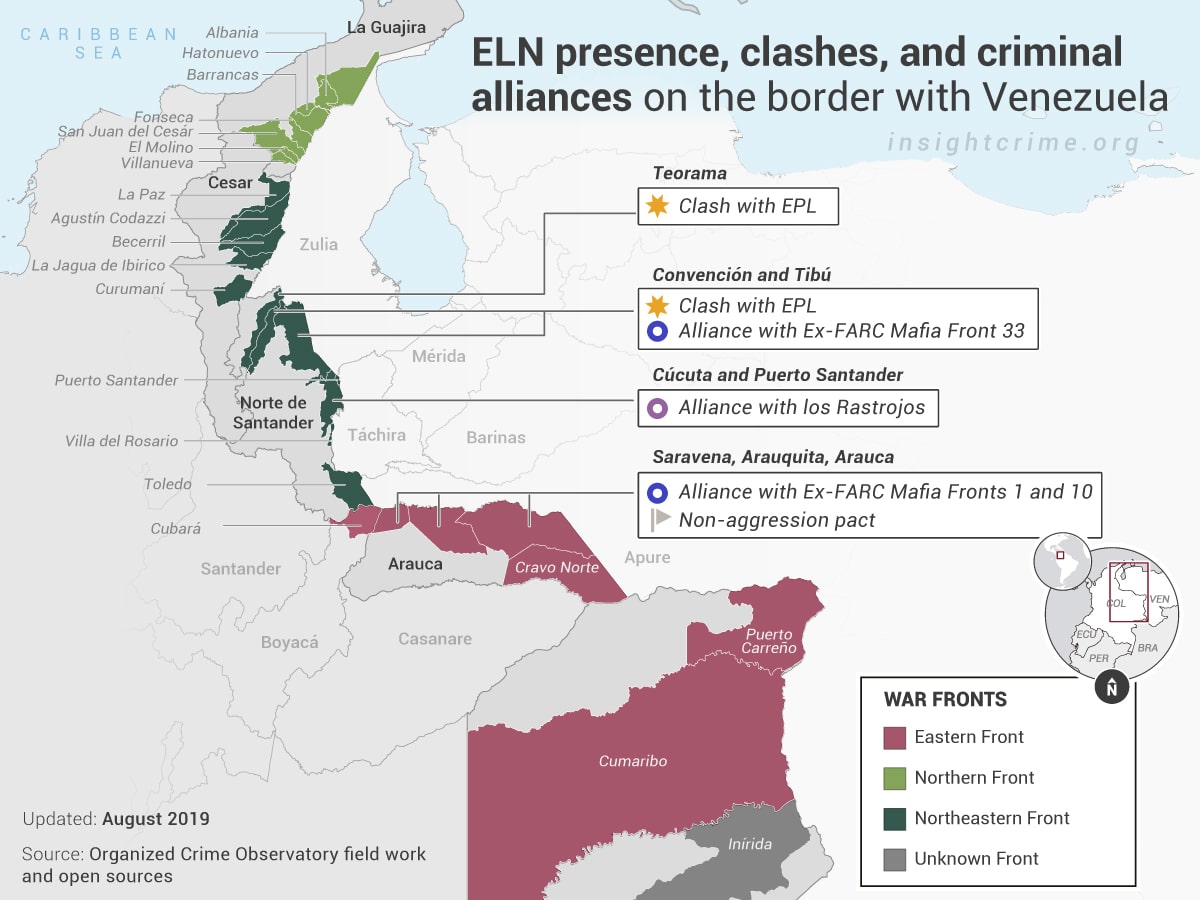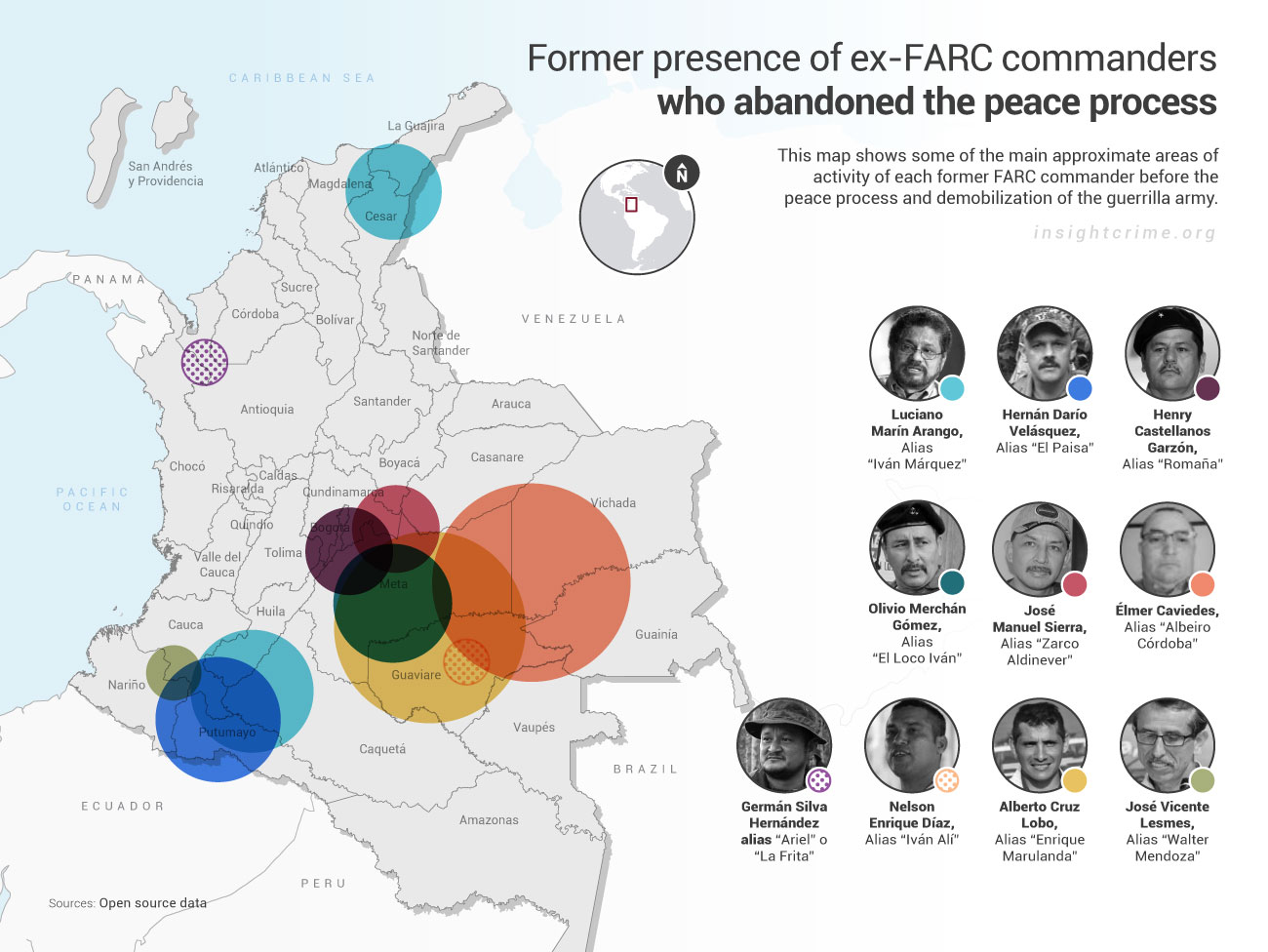In a video published on YouTube, a group of senior former FARC rebel leaders declared their intention to take up arms once again, reviving the FARC-EP and sounding the possible death knell for the Colombian peace process.
In the video, filmed in the jungle around Inírida, Guainía, in southwestern Colombia along the border with Venezuela, Luciano Marin, alias “Iván Márquez,” declares that the Colombian state has “betrayed…the peace accords” that were signed in 2016 between the government and the Revolutionary Armed Forces of Colombia (Fuerzas Armadas Revolucionarias de Colombia – FARC). He added that, as a result, the group would “continue its guerrilla warfare.”
The birth of this new dissident force raises a number of important questions about its membership, its links to other ex-FARC mafia cells, and its potential ties to the Venezuelan government. Furthermore, the announcement has put in jeopardy the future of some 13,000 former FARC guerrillas still participating in the peace process.
1. The New Dissidents
Iván Márquez, who gave the August 29 video address, was the guerrilla group’s second-in-command before its demobilization. His credibility among former FARC troops remains high, and his call will be heard by demobilized FARC considering whether to rejoin the struggle. Márquez is also very familiar with the zones where Colombia’s largest guerrilla force once operated.
In the video, Márquez is flanked by influential former rebel commanders, including Hernán Darío Velásquez, better known as “El Paisa,” and Seuxis Pausías Hernández, alias “Jesús Santrich.”
El Paisa was once the commander of the FARC’s strongest military wing, the Teófilo Forero Column. He stands to play a crucial role in reunifying the FARC, given his deep knowledge of drug trafficking operations in coca-producing regions such as Caquetá, Putumayo and Cauca.
Iván Márquez and El Paisa have long rejected the peace process.
Meanwhile, Santrich’s appearance comes after a period of turmoil for the former guerrilla commander. After being released from jail on drug trafficking charges in May 2019, Santrich took a seat in congress reserved for former FARC members in June. The following month, though, he fled to Venezuela to rejoin his old allies. Santrich, who is almost totally blind, is a well-respected voice within the FARC and will likely play an influential role in forging alliances with other dissident cells.
SEE ALSO: Profile of Luciano Marin Arango, alias ‘Iván Márquez’
The leaders in the video are seen standing before a banner that reads FARC-EP, short for Fuerzas Armadas Revolucionarias de Colombia—Ejército del Pueblo (Revolutionary Armed Forces of Colombia—People’s Army). This was the full name of the guerrilla group prior to its demobilization. By using this name, Márquez and his allies show that they want to be seen as the only legitimate FARC leaders.
2. Areas of Influence
The members of the FARC-EP will be able to wield influence across Colombia. Iván Márquez and El Paisa have power bases around Miravalle, in the southwestern department of Caquetá, where they have operated since the 2016 peace agreement. This area, along with the departments of Putumayo and Cauca, will likely be a major focal point for the dissidents thanks to lucrative drug trafficking economies present there, sources tell InSight Crime. FARC dissident leader Miguel Botache Santillana, alias “Gentil Duarte,” who is notably absent from the video, also controls part of this territory.
Other former top FARC figures seen in the video include José Manuel Sierra, alias “Zarco Aldinever,” Olivio Merchán, alias “Loco Iván,” and Alberto Cruz Lobo, alias “Enrique Marulanda,” all of whom wield influence in the department of Meta, in central Colombia.
Finally, there is José Vicente Lesmes, alias “Walter Mendoza,” who was once tasked with helping to implement the peace agreement in southern Colombia and along its Pacific coast. He is well known among dissident groups in those areas, and could help with the new FARC-EP’s expansion in the region.
3. Where is Gentil Duarte?
Gentil Duarte, the former FARC commander who has been seeking to unite ex-FARC groups in southern Colombia, is perhaps the most important absentee from the video.
It is believed that Duarte has been in contact with ex-FARC leaders including Iván Márquez in recent months, and it is unknown what agreements may exist between them. At the moment, these two groups of ex-FARC mafia risk having overlapping bases of operations.
Claudia Carrasquilla, Colombia’s top public security prosecutor, told InSight Crime that Duarte was present at a meeting with ex-FARC and National Liberation Army (Ejército de Liberación Nacional – ELN) leaders in Venezuela in October 2018. Several figures appearing in the video, including El Paisa, Zarco Aldinever and Nelson Enrique Diaz, alias “Iván Alí,” were also at this meeting, La Silla Vacía reported, although InSight Crime has not confirmed whether Márquez attended.
SEE ALSO: Gentil Duarte’s Master Plan to Reunite Colombia’s FARC Dissidents
4. Relations with the ELN
One of the first points mentioned in Márquez’s speech is a possible alliance between the new FARC-EP and the ELN. The ELN has become Colombia’s most important guerrilla group since the FARC demobilized and has greatly expanded its presence inside Venezuela.
Any alliance between the two groups would immediately expand the territory that this renewed FARC dissident force would be able to operate in. A warm message of support for the FARC-EP’s August 29 announcement came from Jaime Arias, alias “Uriel,” commander of the ELN’s Western War Front.
Furthermore, InSight Crime field work has confirmed that the ELN has already reached agreements with ex-FARC mafia groups, such as a non-aggression pact with the FARC’s former 36th Front in Bajo Cauca and with the 33rd front in the northeastern department of Norte de Santander.

5. Venezuela Stepping into Colombia’s wars
The FARC-EP’s announcement that it will take up weapons may have grave consequences for Colombia and Venezuela. The presence of former FARC leaders, including El Paisa, Santrich and Gentil Duarte, on Venezuelan soil has been heavily suspected. Officials within Duque’s government have repeatedly stated that ex-FARC mafia groups are operating with impunity in Venezuela and with the support of President Nicolás Maduro. Furthermore, InSight Crime research has identified the presence of FARC dissident cells in at least seven Venezuelan states.
Maduro recently commented that “Iván Márquez and Jesús Santrich are welcome in Venezuela…when they want to come. They are two leaders of peace,” according to Reuters.
The October 2018 meeting between ELN and ex-FARC leaders in the state of Apure confirmed that Venezuela was hosting dialogues between these two groups. Beyond ties to the ELN, the ex-FARC mafia are suspected of having criminal ties to a “colectivo” of pro-Maduro paramilitary forces that operate along the Colombian border in the state of Táchira.
Any confirmation of ties, if not support, between the renewed FARC-EP and the Venezuelan state would be taken seriously in Bogotá and could revive calls for foreign intervention.
*This article was written with assistance from InSight Crime’s Colombian Organized Crime Observatory and the Venezuela Investigative Unit.


